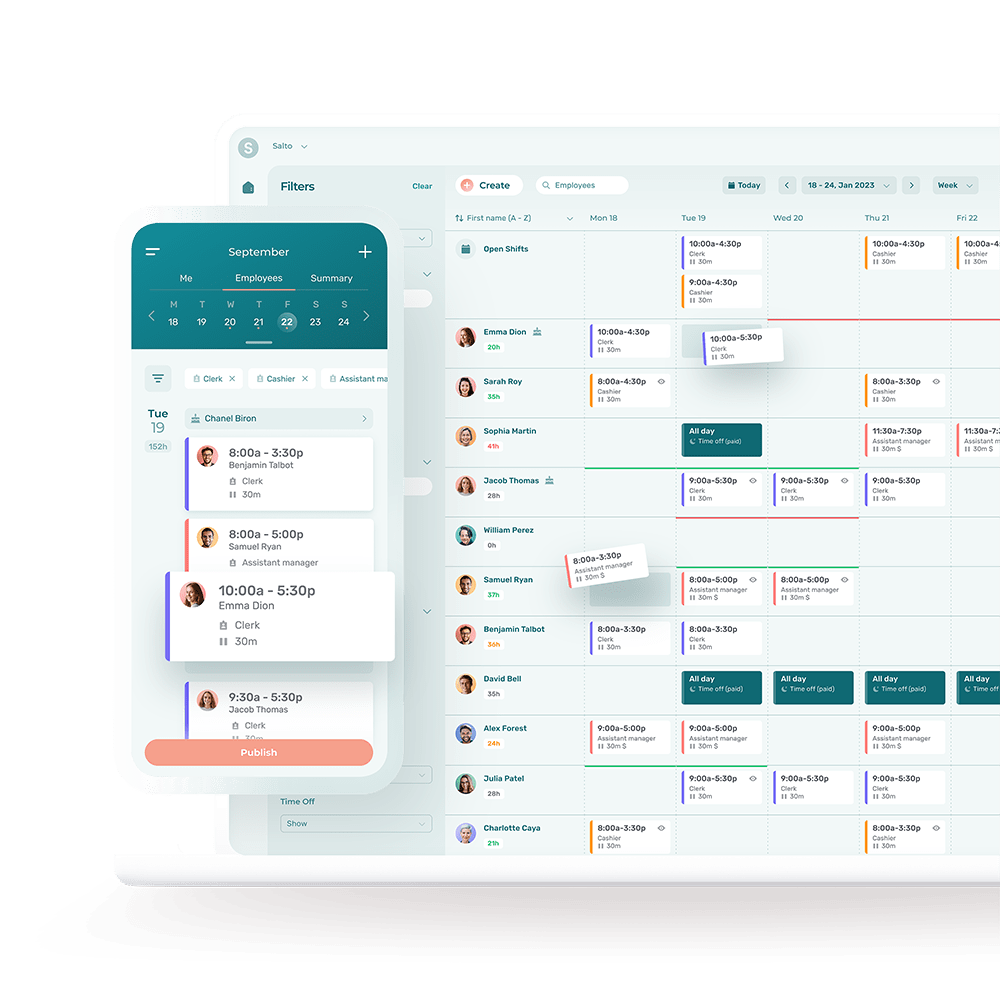Want to use the STAR method to strengthen your recruitment strategy? We’ve put together common STAR method interview questions for interviewers and sample answers for candidates to get you started.
To succeed in business, you need to hire candidates who are a perfect fit for the position. But traditional interview questions don’t always get to the real story behind what a candidate says they can do. That’s where the STAR Method comes in.
Key Takeaways
- Traditional interview questions don’t always reveal key soft skills many positions require—like good communication and problem-solving skills, leading by example, handling pressure or conflict, etc.
- The STAR interview method can be used during behavioral job interviews to pinpoint specific soft skills required for a position.
- The acronym STAR stands for Situation, Task, Action, and Result.
- With the STAR interview technique, the interviewer or hiring manager asks open questions. Each question targets a different soft skill the candidate will need to succeed in the new role.
- To answer each interview question, job seekers are expected to provide a real life example of how they dealt with that particular situation in their last job.
- There is no perfect answer to a behavioral interview question; however, a good answer according to the STAR format is structured around the 4 elements: situation, task, action, and result.
- Both recruiters and job seekers can use the STAR interview method to ensure a more successful interview process.
- The STAR interview technique can be used by businesses of any size for behavioral interviewing, regardless of industry.
This guide explains what the STAR method interview technique is, how it’s used, and what types of questions recruiters frequently ask to get a more accurate picture of candidates: not only what they can do, but also how they are likely to act in common real life situations. This reveals essential soft skills like problem-solving, teamwork, leadership, communication, etc.—which many traditional interview questions fail to capture.
You’ll find in this article common interview questions and answers to show recruiters and job seekers exactly how the STAR technique works.
What Is the STAR Method? ⭐
The STAR Method is a structured approach to answering behavioral interview questions recruiters commonly ask, like: “Describe a time when…”, Can you give me an example of…”, etc. Candidates frame their answers around the Situation, Task, Action, and Result.
Situation: The candidate briefly describes the situation to set the scene, skipping any unnecessary details.
Task: The candidate then explains the actual challenge or task they faced, focusing on their specific responsibilities or what was expected of them.
Action: Next, the candidate details the steps they took to address the task or challenge, focusing on their personal contribution.
Result: Lastly, the candidate shares the outcomes of their actions, focusing on the impact, what they learned, and when possible, quantifiable results.
By framing answers in this way, candidates can articulate their past work experiences clearly and concisely while focusing on specific instances where they demonstrated skills and competencies relevant to the position.
STAR Method Questions vs. Traditional Interview Questions
The STAR Method is considered to be a better indicator of a candidate’s future performance compared to traditional job interview questions, which often assess general qualifications, skills, or hypothetical scenarios that are not necessarily tied to specific past events.
Examples of typical interview questions
- Tell me about yourself.
Examples of typical behavioral questions (STAR) : Tell me about a time when you solved a particularly challenging situation at work.
- What are your strengths and weaknesses?
Examples of typical behavioral questions (STAR) : Can you share an example of when you achieved a goal you’re particularly proud of?
- Why do you want to work here?
Examples of typical behavioral questions (STAR) : Describe a time when you made a mistake at work and how you handled it.
- Where do you see yourself in five years?
Examples of typical behavioral questions (STAR) : Have you ever faced conflict with a coworker? What did you do and what was the outcome?
STAR Method for Recruiters and Employers
Recruiters and hiring managers often use the STAR method during interviews to get candidates to share examples of how they handled specific work situations in the past.
When Is the STAR Method Used?
The STAR method is particularly useful in:
- Behavioral interviews: understanding how the candidate has behaved in certain work situations in their previous jobs.
- Assessing competencies: such as teamwork, leadership, problem-solving, and adaptability. By asking candidates to describe situations where they demonstrated these skills, interviewers can get a clearer picture of the candidate’s abilities and work style.
Struggling to attract quality workers? Here are 7 Practical Tips to Hire the Right Candidate
How Is the STAR Method Used?
- Preparation: recruiters and managers prepare a set of behavioral questions that align with the job’s key required competencies. These questions are designed to coax stories out of candidates that reveal their skills and approach to work.
- During interviews: when a candidate is asked a behavioral question, the interviewer expects the response to be structured according to the STAR method. This means the candidate should describe a specific Situation, outline the Task required, detail the Actions they took, and highlight the Results achieved.
- Evaluation: interviewers listen for detailed responses that follow the STAR structure, as it helps them evaluate the candidate’s problem solving ability, adaptability, and other relevant soft skills. They assess not only the outcome or the result of the actions taken but also the thought process, initiative, and problem solving approach demonstrated by the candidate.
- Follow-up questions: recruiters and managers may ask follow-up questions to dive deeper into any part of the candidate’s story. This can help clarify certain points and provide additional insights into the candidate’s capabilities and potential fit for the role.
- Decision-making: the detailed responses elicited by STAR questions enable interviewers to make more informed hiring decisions. They can compare the competencies and behaviors of various candidates based on how well their past actions align with the needs of the role and the organization’s culture.
Why Use the STAR Method?
The STAR method is widely used across various industries for interviews, including but not limited to healthcare, technology, finance, education, retail, and hospitality. Its versatility in evaluating behavioral competencies makes it applicable to roles ranging from entry-level positions to senior management.
By asking the candidate open behavioral questions, recruiters and employers can draw out important information about the candidate’s key skills and attributes via real life examples. This makes it easier to evaluate the candidate’s suitability for the role—not only in terms of skill compatibility but also cultural fit and competency.
How to Conduct an Interview Using the STAR Method
To effectively use the STAR method in interviews, it’s crucial to first identify the key competencies and skills relevant to the job role and then prepare behavioral questions that align with these areas.
For example, if the position is for a sales representative and requires outstanding customer management skills, a good STAR question might be: “Did you ever have a major client that threatened to take their business elsewhere? How did you handle it?”
If the position is for a scheduling manager overseeing multiple store locations and requires excellent communication and organizational skills, a good STAR question might be: “Can you think of a time when poor internal communication resulted in things like missed shifts, inaccurate timesheets, or increasing employee turnover? How did you resolve it?”
7 tips for getting the most from the STAR method
- Ask specific questions that focus on the role’s key required skills and competencies.
- Avoid asking vague or hypothetical questions; they’ll only lead to vague or hypothetical answers, not actual past behavior.
- Create a calm and balanced interview environment that allows the candidate to share meaningful examples that demonstrate their suitability for the role.
- Listen carefully to the candidate’s answers; make sure they cover all aspects of the STAR framework in their responses.
- Be mindful of common interview mistakes, such as a candidate providing answers that are not directly relevant to the question, are too vague, or do not conclude with a positive outcome.
- If needed, prompt or guide the candidate to elaborate on specific points, such as the specific actions they took or the results of those actions.
- Document the candidate’s responses to STAR questions and other interview questions to create a reliable reference for post-interview discussions and decision-making.
How to Prepare for the STAR Method of Interviewing
Recruiters can use the following guidelines to effectively leverage the STAR method to gain meaningful insights into candidates’ past experiences and behaviors. This will ultimately lead to more informed hiring decisions.
- Understand the STAR formula: Situation, Task, Action, and Result.
- Remember that this method is used in behavioral interviews to assess candidates’ past experiences and their approach to specific situations, offering insight into their problem-solving, decision-making, interpersonal skills, and compatibility with the corporate culture.
- Identify key competencies for the role and craft specific behavioral interview questions that prompt candidates to share specific experiences that reveal their skills and behavior in previous roles.
Examples of Interview Questions Using the STAR Method
Here are 10 concrete examples of STAR questions that recruiters can ask and the skills they assess:
1. Describe a situation where you had to meet a tight deadline. How did you manage your time and resources to deliver on time?
-
- Assesses: time management and prioritization skills.
2. Can you give an example of a challenging project you worked on and the specific actions you took to ensure its success?
-
- Assesses: problem-solving and project management abilities.
3. Tell me about a time when you faced a conflict with a coworker. How did you handle it, and what was the outcome?
-
- Assesses: conflict resolution and teamwork skills.
4. Share an instance where you had to adapt to significant changes at work. What was your approach, and how did it turn out?
-
- Assesses: adaptability and change management.
5. Give me an example of when you went above and beyond your job responsibilities. What drove you to do it, and what was the result?
-
- Assesses: initiative and extra-mile efforts.
6. Can you describe a situation where you had to use data or analytics to make a decision? What was the process, and what was the impact of your decision?
-
- Assesses: analytical thinking and decision-making based on data.
7. Tell me about a time when you had to learn something new quickly. How did you approach the learning process, and were you successful?
-
- Assesses: learning agility and ability to quickly acquire new skills.
8. Describe a project where you led the team. What was your leadership style, and how did you ensure the team’s success?
-
- Assesses: leadership skills and team management.
9. Share an example of how you dealt with a dissatisfied or difficult customer. What actions did you take, and what was the outcome?
-
- Assesses: customer service skills and empathy.
10. Can you talk about a time when you had to prioritize multiple projects or tasks? How did you determine the priorities, and what was the result?
-
- Assesses: organizational and time management skills, ability to prioritize and juggle multiple responsibilities.
STAR Method for Job Seekers
Why Do Recruiters Use the STAR Method?
Recruiters use the STAR Method because it gives them an easy way to understand a candidate’s past behavior in real-world work scenarios. This is often considered to be the best predictor of future performance.
By asking candidates to describe specific Situations they’ve encountered, the Tasks they were responsible for, the Actions they took, and the Results of those actions, recruiters can gain insights into candidates’ problem-solving, teamwork, leadership, and other relevant skills.
The STAR method helps recruiters:
- Evaluate the candidate’s critical thinking, decision-making, and interpersonal skills.
- Assess the candidate’s achievements and failures, providing a more comprehensive view of their capabilities.
- Understand how candidates have handled situations in the past to determine whether they make a good cultural fit for the company.
How job candidates can use the STAR Method to ace their next interview
- Be prepared: reflect on your past experiences and prepare stories that highlight your skills and achievements related to the job you’re applying for. This will allow you to confidently articulate clear and concise responses during the interview.
- Be specific: by focusing on specific examples, you can provide detailed insights into your professional behavior and decision-making processes, demonstrating your suitability for the role.
- Highlight results: quantify your achievements in your responses; use numbers or statistics when possible to make a stronger impact and showcase your contribution to past successes.
How to Prepare for an Interview Using the STAR Method
Candidates can use the STAR method to prepare for an upcoming job interview. Simply follow these steps:
- Understand the STAR method: familiarize yourself with how a STAR method interview works. You will need to cover four things: Situation, Task, Action, and Result. Each one serves a specific purpose in illustrating your experience and skills.
- Reflect on past experiences: review your professional history and identify instances where you successfully navigated challenges, led a team, solved problems, or achieved significant results. Look for varied experiences that highlight a range of skills and abilities.
- Match experiences to job requirements: analyze the job description to understand the key competencies and skills required for the role. Match your identified experiences to these requirements, ensuring you have a relevant story for each skill or competency the employer is seeking.
- Structure your responses: for each chosen experience, outline your response using the STAR framework. Ensure you set the scene with the Situation, define your role with the Task, describe the Actions you took, and highlight the Results achieved. Be as specific and detailed as possible, particularly with the actions and results.
- Quantify results: if possible, quantify the outcomes of your actions to demonstrate the impact of your contributions. Use numbers, percentages, or other metrics to make your achievements more tangible and impressive.
- Practice your responses: start practicing interview questions and answers ahead of your next job interview. Familiarize yourself with common behavioral interview questions and practice giving an example answer to each one. Consider practicing with a friend or mentor who can provide feedback. There’s no perfect answer to STAR questions, but if your answer follows the STAR formula and sounds natural and not rehearsed, then chances are the interviewer will consider it a good answer.
- Prepare for variations: be ready for variations in questioning. Recruiters might phrase questions differently, so ensure your prepared stories can be adapted to answer various behavioral questions effectively.
- Review common mistakes: be aware of common pitfalls, such as being too vague, not focusing on positive outcomes, or not being prepared with specific examples. Ensure your stories are relevant, focused, and highlight your successes.
- Be honest: always ensure your stories are truthful and reflect your genuine experiences. Authenticity is key in building trust with your interviewer and ensuring that your skills and experiences are accurately represented.
- Stay calm and confident: approach the interview with confidence in your preparation and abilities. Staying calm will help you think clearly and deliver your responses more effectively.
How job seekers should answer STAR interview questions
Step 1 – Listen & think: Pay attention to the question to determine which skill or experience the interviewer is probing. Then take a few seconds to think about which particular situation is most appropriate. Also, think about how you will answer the question in the STAR format. The goal is to talk about a meaningful real life example.
Step 2- Explain the situation: Briefly describe the context, including where and when the situation occurred, and any relevant details that provide a clear background for your story. Keep this part concise to maintain the interviewer’s interest.
Step 3 – Describe the task: Clearly articulate the challenge or responsibility you were faced with. This should be a specific task or problem that required your attention and skills. It’s important to clarify your role in the situation to give the interviewer a sense of the ownership and responsibility you had.
Step 4 – Detail the action: This is the heart of your response. Detail the specific actions you took to address the task or challenge. Focus on “I” rather than “we” to emphasize your contributions, even if you were part of a team. Describe the steps you took, any skills or tools you used, and how you navigated any obstacles.
Step 5 – Share the result: Conclude with the outcomes of your actions. Highlight the success of your efforts with quantifiable results if possible, such as percentages, numbers, or specific achievements. Also, reflect on what you learned from the experience and how it contributed to your professional growth.
Examples of Answers Using the STAR Method
Below are examples of how job seekers could answer common STAR interview questions.
Example 1
Industry: Offices & call centers
Position: Marketing Manager
STAR question: Were you ever confronted with a tight deadline? How did you handle it and what was the outcome?
Skills targeted by question: Handling tight deadlines, prioritizing tasks, delegation, negotiation skills, time management.
Example answer:
- Situation: “In my previous role as the coordinator of a marketing team, we were tasked with launching a new product within a month, which was half the usual timeline.”
- Task: “I was responsible for the digital marketing campaign, which included social media, email marketing, and online advertising.”
- Action: “I prioritized tasks, delegated social media to a junior team member, and automated the email campaign. I also negotiated faster turnaround times with our advertising partners.”
- Result: “We launched the campaign on time, resulting in a 20% increase in online engagement compared to previous launches. This experience taught me the importance of effective time management and delegation.”
Example 2
Industry: Restaurants & bars
Position: Restaurant Manager
STAR question: Describe a time when you needed to settle a dispute between colleagues. What steps did you take to resolve the matter?
Skills targeted by question: Leadership, conflict resolution, communication, ability to handle stressful situations and fast-paced environments.
Example answer:
- Situation: “In my role as an assistant manager at a busy downtown bistro, two of our chefs had a major conflict during one dinner rush. The disagreement was over the preparation method of a new dish, which was causing delays and tension in the kitchen.”
- Task: “As the manager on duty, I had to quickly resolve the conflict to maintain kitchen efficiency and ensure the quality of our service was not compromised.”
- Action: “I immediately called for a brief timeout in the kitchen and pulled the two chefs aside. I listened to each of their concerns and perspectives separately to understand the root of the disagreement. I knew that the stress of the dinner rush might have amplified the conflict, so I suggested a compromise for the evening’s service and scheduled a more in-depth meeting for the following day. I also reminded them of our common goal to provide excellent cuisine and service to our guests.”
- Result: “The chefs agreed to the compromise, and we successfully continued the service without further issues. The next day, during the meeting, we collaboratively developed a standardized preparation method for the new dish. This not only resolved the conflict but also became a best-selling item on our menu. This experience reinforced the importance of clear communication and teamwork in a high-pressure environment, and it taught me valuable conflict-resolution skills that I’ve continued to apply in my management style.”
Example 3
Industry: Healthcare
Position: Department Head at a seniors’ residence
STAR question: Have you ever had to overcome a personal challenge in your previous role? How did you rise to the occasion?
Skills targeted by question: Ability to adapt to rapid change, initiative, leadership, ability to quickly learn new skills, team player.
Example answer:
- Situation: “When I was a department head at a nursing home, our facility decided to transition to a new electronic health record (EHR) system to improve patient care and data accuracy. This was a significant change from our previous, more manual processes.”
- Task: “As part of the senior management team, my task was to lead my department through this transition smoothly. The goal was to minimize disruption to patient care and maintain our high standards of service.”
- Action: “I knew that adapting to new technology might be challenging for some team members, so I initiated a comprehensive training program. I brought in experts for detailed workshops. I also established a support system where staff could easily seek help during the initial phase of the transition. To lead by example, I made sure to become proficient in the new system quickly. This allowed me to assist my team directly and address any concerns effectively.”
- Result: “The transition was successful and my team was one of the first in the residence to fully adapt to the new EHR system. We improved our operational efficiency by 30%. Personally, this experience taught me the value of resilience and continuous learning in the ever-evolving healthcare sector.”
Example 4
Industry: Retail
Position: Regional Store Manager
STAR question: Can you think of an accomplishment you are particularly proud of? What was your contribution and what was the outcome?
Skills targeted by question: Initiative, leadership, project management, customer engagement, ability to make data-driven decisions.
Example answer:
- Situation: “While working as a store manager at a mid-sized clothing retailer, I noticed that our store layout hadn’t been updated in several years. This was leading to stagnant sales and an uninspiring shopping environment.”
- Task: “I proposed and was tasked with leading a project to redesign the store layout to create a more engaging shopping experience to increase foot traffic and sales.”
- Action: “I began by analyzing customer flow patterns and gathering feedback from staff and shoppers. Based on this data, I collaborated with a small team to develop a new layout that highlighted key product lines and created more open, inviting spaces. We also introduced interactive displays. I oversaw the implementation and coordinated with vendors and staff to minimize disruption during the redesign.”
- Result: “The new layout was well-received by customers, leading to a 25% increase in foot traffic and a 15% rise in overall sales within the first three months. This project improved our store’s performance and taught me valuable lessons in project management, customer engagement, and the impact of physical space on retail success.”
Conclusion
The STAR method can significantly elevate your recruitment strategy. Don’t hesitate to use it in your next job interview; its structured approach will help you uncover the true potential of candidates, streamline the evaluation process, and improve the quality of your hiring decisions.
Here’s to making sure each hire contributes meaningfully to your organization’s success!
Other Helpful Resources and Interview Guides
Free Downloadable Word Forms
- Employment application form—Collect the necessary information to quickly assess whether applicants meet basic position requirements
- Interview guide template—Determine whether applicants are a good fit for your organization
- Reference form—Get a better perspective of applicants
- Pre-employment screening consent and release form—Obtain the consent of applicants transparently before performing background checks
Blog Articles
What Is the STAR Method of Interviewing?
The STAR method of interviewing involves asking candidates behavioral interview questions that target the specific soft skills required by a given position. Job seekers must frame their answers around four key elements:
- Situation — Setting the context
- Task — Explaining the challenge
- Action — Detailing the steps taken
- Result — Highlighting the outcomes
This method helps candidates provide clear, concise, and organized responses that demonstrate their skills and experiences effectively.
What Are the 4 Steps to Answering Questions in the STAR Method?
- Situation: Describe the context within which you performed a task or faced a challenge. This sets the scene for your story.
- Task: Explain the actual challenge or task at hand. This part focuses on your specific responsibilities or what was expected of you.
- Action: Detail the specific steps you took to address the task or challenge. This is where you discuss your personal contribution.
- Result: Share the outcomes of your actions, focusing on the impact and what you learned. Quantify the results when possible.
What Is an Example of the STAR Approach?
Here’s an example of using the STAR approach in response to the open interview question: “Tell me about a time when you had to deal with a difficult customer. What steps did you take and what was the outcome?”
- Situation: “At my previous job in retail, during a particularly busy holiday season, a customer was upset because the toy they wanted to purchase for their child was out of stock.”
- Task: “As the store manager, it was my responsibility to address the customer’s concerns and find a satisfactory resolution.”
- Action: “I apologized for the inconvenience and explained our stock issue due to high demand. I then offered to check our inventory system for nearby store availability and found that a neighboring location had the toy in stock. I called the other store to reserve the item.”
- Result: “The customer was relieved and grateful for the effort. They left the store satisfied, and later that week, they wrote a positive review online praising our customer service. This experience taught me the value of proactive problem-solving and maintaining composure under pressure.”
This response to this STAR question demonstrates the candidate’s ability to handle difficult situations, provide excellent customer service, and turn a potentially negative experience into a positive one.
What Are the 5 STAR Interview Questions?
There are endless questions a recruiter may ask during a job interview, but most STAR interview questions focus on the following 5 themes:
- Solving challenging situations
- Achieving goals
- Making mistakes
- Handling conflicts
- Handling pressure
It can be beneficial for job candidates to prepare answers to these common behavioral interview questions, regardless of the position or industry in question.












